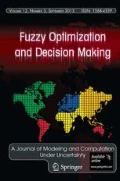Abstract
Fuzzy numbers have been applied on decision and optimization problems in uncertain or imprecise environments. In these problems, the necessity to define optimal notions for decision-maker’s preferences as well as to prove necessary and sufficient optimality conditions for these optima are essential steps in the resolution process of the problem. The theoretical developments are illustrated and motivated with several numerical examples.


Similar content being viewed by others
References
Buckley, J. J. (1987). The fuzzy mathematics of finance. Fuzzy Sets and Systems, 21, 257–273.
Campos-Ibáñez, L. M., & González-Muñoz, A. (1989). A subjective approach for ranking fuzzy numbers. Fuzzy Sets and Systems, 29, 145–153.
Campos, L., & Gonzalez, A. (1994). Futher contributions to the study of the average value for ranking fuzzy numbers. International Journal of Approximate Reasoning, 10, 135–153.
Chalco-Cano, Y., Lodwick, W. A., Osuna-Gómez, R., & Rufián-Lizana, A. (2016). The Karush–Kuhn–Tucker optimality conditions for a fuzzy optimization problems. Fuzzy Optimization and Decision Making, 15, 57–73.
Chalco-Cano, Y., Rufián-Lizana, A., Román-Flores, H., & Osuna-Gómez, R. (2013). A note on generalized convexity for fuzzy mappings through a linear ordering. Fuzzy Sets and Systems, 213, 70–80.
Dubois, D., & Prade, H. (1987). The mean value of a fuzzy number. Fuzzy Sets and Systems, 24, 279–300.
Fachinetti, G., Giove, S., & Pacchiaroti, N. (2002). Optimisation of a non linear fuzzy fucntion. Soft Computing, 6, 476–480.
Goestschel, R., & Voxman, W. (1986). Elementary fuzzy calculus. Fuzzy Sets and Systems, 18, 31–43.
González, A. (1990). A study of the ranking function approach through mean values. Fuzzy Sets and Systems, 35(1), 29–41.
Guerra, M. L., Sorini, L., & Stefanini, L. (2011). Options priece sensitives through fuzzy numbers. Computers and Mathematics with Applications, 61, 515–526.
Hanson, M. A. (1981). On sufficiency of the Kuhn–Tucker conditions. Journal of Mathematical Analysis and Applications, 80, 545–550.
Ishibuchi, H., & Tanaka, H. (1990). Multiobjective programming in optimization of the interval objective function. European Journal of Operational Research, 48, 219–225.
Osuna-Gómez, R., Chalco-Cano, Y., Rufián-Lizana, A., & Hernández-Jiménez, B. (2016). Necessary and sufficient conditions for fuzzy optimality problems. Fuzzy Sets and Systems, 296(1), 112–123.
Panigrahi, M., Panda, G., & Nanda, S. (2008). Convex fuzzy mapping with differentiability and its application in fuzzy optimization. European Journal of Operational Research, 185, 47–62.
Román-Flores, H., & Rojas-Medar, M. (2002). Embedding of level-continuous fuzzy sets on Banach spaces. Infomation Sciences, 144, 227–247.
Stefanini, L., & Bede, B. (2009). Generalized Hukuhara differentiability of interval-valued functions and interval differential equations. Nonlinear Analysis, 71, 1311–1328.
Tsumura, Y., Terano, T., & Sugeno, M. (1981). Fuzzy fault tree analysis. Summary of Papers on General Fuzzy Problems, Report no. 7 (pp. 21–25).
Wu, H. C. (2007a). The Karush–Kuhn–Tucker optimality conditions in an optimization problem with interval-valued function. European Journal of Operational Research, 176(1), 46–59.
Wu, H. C. (2007b). The Karush–Kuhn–Tucker optimality conditions for the optimization problem with fuzzy-valued objective function. Mathematical Methods of Operations Research, 66, 203–224.
Wu, H. C. (2009a). The Karush–Kuhn–Tucker optimality conditions for multi-objective programming problems with fuzzy-valued objective functions. Fuzzy Optimization and Decision Making, 8, 1–28.
Wu, H. C. (2009b). The optimality conditions for optimization problems with convex constraints and multiple fuzzy-valued objective functions. Fuzzy Optimization and Decision Making, 8, 295–321.
Yager, R. R. (1981). A procedure for ordering fuzzy subsets of the unit interval. Information Sciences, 24, 143–161.
Author information
Authors and Affiliations
Corresponding author
Additional information
The research in this paper has been supported by MTM2015-66185 (MINECO/FEDER, UE) and Fondecyt-Chile, Project 1151154.
Rights and permissions
About this article
Cite this article
Osuna-Gómez, R., Hernández-Jiménez, B., Chalco-Cano, Y. et al. Different optimum notions for fuzzy functions and optimality conditions associated. Fuzzy Optim Decis Making 17, 177–193 (2018). https://doi.org/10.1007/s10700-017-9269-9
Published:
Issue Date:
DOI: https://doi.org/10.1007/s10700-017-9269-9




